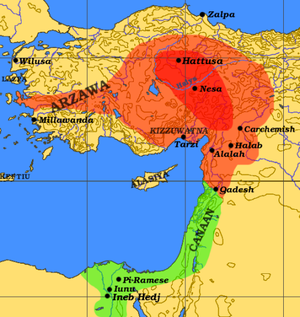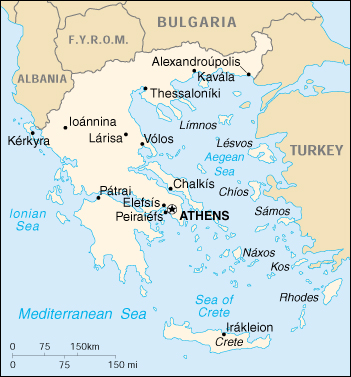Task 6: Library at Anatolia (Hittites)
In this next exercise you are going to be taking a look at the Hittite empire.
I could have chosen any empire from any period from this region but I just happen to chose the Hittites.

This task requires you answer the following questions.
What part of the world was the Hittite empire found?
What was the name of their writing?
What was the name of their primary Deities
Finally conclude how the Hittite civilization has contributed to the historical record of that period and area.
Read the following extracts and then write your answer.
Now before we start I just want you to gather your bearings and take a quick look at the image below
and note the countries surrounding Ancient Greece.

So Greece is next to Turkey (our Hittite empire).
It is also next to Cyprus and Italy and Northern Africa and southern Europe.
And it has a natural harbour and a natural moat.
Anyway. That was just a quick geography refresher. But this task is not about Greece.
This task is about our Hittite friends in Turkey.
Okay. Read the extracts below and then answer the above questions.
Extract 1:
...At the end of the 19th century the Frenchman Ernest Chantre,
during an explorative expedition in Turkey, in the site of BoÄŸazköy,
found some fragments of clay tablets written in a language similar to the one of the Amarna letters.
He suggested that the Armana letters had come from this site.
It was, however, a German expedition that got the permission to start excavation in BoÄŸazköy.
The site revealed the ruins of Hattuša, the capital city of the Hatti reign.
It was not the capital of the Arzawa kingdom, a region today located in western Anatolia.
Excavations began in 1906 under the direction of the German philologist Hugo Winckler and are still ongoing.
Over the years ca. 30,000 fragments of cuneiform tablets have been found.
Tablets were unearthed in different locations of the city, in particular in the Lower City,
occupied by a vast temple quarter which also included administration buildings,
workshops and storerooms, in the citadel area Büyükkale, place of the king’s residence,
and in the High City, occupied by another temple quarter with several temples...
See the full article here:
http://lila.sns.it/mnamon/index.php?page=Scrittura&id=16&cont=209&lang=en&PHPSESSID=ac4a5978caa15f9eabeef951a8792315
Extract 2:

...His name in Luwian, and probably also in Hittite, was Tarhun (Tarhund)...
...He is associated with the sacred bull and appears on monuments
either attended by a pair of divine bulls or driving over mountains in a chariot drawn by bulls.
In the cult itself Tarhun might even be represented by a bull.
As Tarhun’s spouse, the great goddess of the city of Arinna was exalted as patroness of the state.
(Arinna has not been located, but it was situated somewhere in the heartland of the Hittite kingdom,
within a day’s journey of the capital) ...
...the Hittites worshiped her under the epithet Arinnitti.
She is always called a sun goddess, and sun disks appear as emblems in her cult, ...
See the full article here:
http://www.britannica.com/EBchecked/topic/22949/Anatolian-religion/68316/The-pantheon
Okay. Answering the question.
In your introduction sentence state that the Hittites were one of many interesting civilisations;
along with the Mesopotamians, Chaldeans and Babylonians
In your next three sentences mention that the Hittites were located in present day Turkey,
Say that their writings were cuneiform.
Next say that the Male Deity was associated with a devine bull, and that the female Deity was represented by a sun disc.
Finally write a concluding sentence giving your opinion on the discovery of such a vast cache of cunieform tablets;
and how it will contribute to the historical record of the area - (convenient maybe!)
I could have chosen any empire from any period from this region but I just happen to chose the Hittites.

This task requires you answer the following questions.
What part of the world was the Hittite empire found?
What was the name of their writing?
What was the name of their primary Deities
Finally conclude how the Hittite civilization has contributed to the historical record of that period and area.
Read the following extracts and then write your answer.
Now before we start I just want you to gather your bearings and take a quick look at the image below
and note the countries surrounding Ancient Greece.

So Greece is next to Turkey (our Hittite empire).
It is also next to Cyprus and Italy and Northern Africa and southern Europe.
And it has a natural harbour and a natural moat.
Anyway. That was just a quick geography refresher. But this task is not about Greece.
This task is about our Hittite friends in Turkey.
Okay. Read the extracts below and then answer the above questions.
Extract 1:
...At the end of the 19th century the Frenchman Ernest Chantre,
during an explorative expedition in Turkey, in the site of BoÄŸazköy,
found some fragments of clay tablets written in a language similar to the one of the Amarna letters.
He suggested that the Armana letters had come from this site.
It was, however, a German expedition that got the permission to start excavation in BoÄŸazköy.
The site revealed the ruins of Hattuša, the capital city of the Hatti reign.
It was not the capital of the Arzawa kingdom, a region today located in western Anatolia.
Excavations began in 1906 under the direction of the German philologist Hugo Winckler and are still ongoing.
Over the years ca. 30,000 fragments of cuneiform tablets have been found.
Tablets were unearthed in different locations of the city, in particular in the Lower City,
occupied by a vast temple quarter which also included administration buildings,
workshops and storerooms, in the citadel area Büyükkale, place of the king’s residence,
and in the High City, occupied by another temple quarter with several temples...
See the full article here:
http://lila.sns.it/mnamon/index.php?page=Scrittura&id=16&cont=209&lang=en&PHPSESSID=ac4a5978caa15f9eabeef951a8792315
Extract 2:

...His name in Luwian, and probably also in Hittite, was Tarhun (Tarhund)...
...He is associated with the sacred bull and appears on monuments
either attended by a pair of divine bulls or driving over mountains in a chariot drawn by bulls.
In the cult itself Tarhun might even be represented by a bull.
As Tarhun’s spouse, the great goddess of the city of Arinna was exalted as patroness of the state.
(Arinna has not been located, but it was situated somewhere in the heartland of the Hittite kingdom,
within a day’s journey of the capital) ...
...the Hittites worshiped her under the epithet Arinnitti.
She is always called a sun goddess, and sun disks appear as emblems in her cult, ...
See the full article here:
http://www.britannica.com/EBchecked/topic/22949/Anatolian-religion/68316/The-pantheon
Okay. Answering the question.
In your introduction sentence state that the Hittites were one of many interesting civilisations;
along with the Mesopotamians, Chaldeans and Babylonians
In your next three sentences mention that the Hittites were located in present day Turkey,
Say that their writings were cuneiform.
Next say that the Male Deity was associated with a devine bull, and that the female Deity was represented by a sun disc.
Finally write a concluding sentence giving your opinion on the discovery of such a vast cache of cunieform tablets;
and how it will contribute to the historical record of the area - (convenient maybe!)


